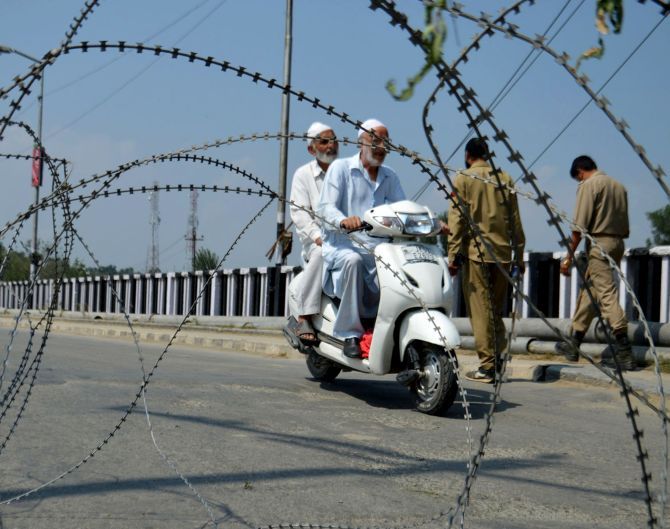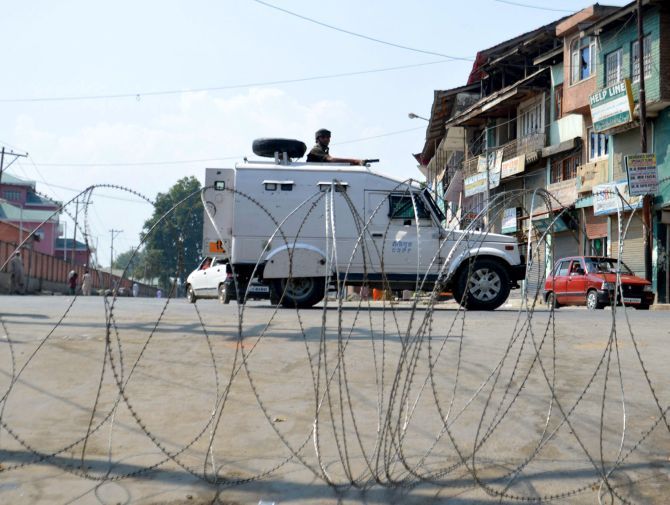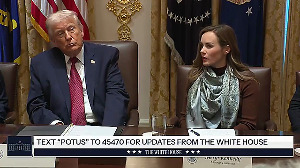'Normalcy does not mean an absence of violence.'
'It aims to re-establish the writ of the State and resume governance.'
'To do that, frayed tempers in the streets and in the media need to be calmed.'
'People need to reflect what has been gained and lost during this period,' says Lieutenant General Syed Ata Hasnain (retd).

In one of the longest stand-offs on the streets in the Kashmir Valley, the police and the youth have been through a dance of death and destruction.
It has led to enhanced mistrust, utter discomfort to a majority of the population, economic paralysis of the region and scores of casualties.
Rabble rousing through Pakistan's paid mouthpieces has multiplied the negative effect and the political community has been rendered ineffective due to its inability to move freely in the valley.
In the midst of it, sincere efforts by the home minister and chief minister have been visible to all with the latter assuming a strong position against allowing the streets to be ruled by the lumpens.
Yet the control of decisions to continue the turbulence does not lie in the hands of the senior Hurriyat leaders, but rather in a non-descript and diffused leadership which the intelligence agencies would surely know by now.
It has morphed well with the people and is manipulated by Pakistan's Deep State which has pulled out all the stops this time.
The difference from the past has been the presence of terrorists among the ranks of the protestors, focused targeting of J&K police personnel, emphasis on stone throwing in rural areas in south Kashmir in particular and the displayed propensity to last it out with full stamina.
In an attempted last resort the Indian Army has been asked to redeploy in greater strength in South Kashmir and restore normalcy.
It needs to be understood that 'normalcy' does not mean an absence of violence. It aims to re-establish the writ of the State and resume governance which has taken a back seat for the last few weeks.
To do that, the streets need to cool down, frayed tempers, both in the streets and in the media, need to be calmed and people need to reflect what has been gained and lost during this period.
In order to cool the environment and simultaneously commence a modicum of effective governance, a few measures could be suggested on the basis of past experience and known best practices from around the world.
In suggesting these I know I am opening a line for severe criticism as well as agreement. This is not something to be afraid of.
As long as ideas are within the ambit of the Indian Constitution there is ample scope to be proactive.
Ten measures are being outlined by me not as just benign ways of cooling the streets but also with the intent of regaining full control to establish the writ of the State towards governance.
There is no inter se priority accorded to these and almost all of them have to be executed simultaneously.
While doing the above I am also acutely mindful of the fact that the army has moved into South Kashmir to reinforce the existing Rashtriya Rifles formations and units. Just for public information it should be known that the Rashtriya Rifles is a group from within the army, with permanent presence in J&K; its officers and men are turned over but institutionally it provides continuity.

First, control of the public order situation must be attempted in strength, but no attempt to arrest should be made at the time of demonstrations. This will prevent the chasing of protestors and the consequent disadvantage that the policemen put themselves to.
Arrests should only be of identified bad hats and of known leaders in the smaller towns and villages. The Rashtriya Rifles knows them as do the intelligence agencies and the J&K police.
The detention should be done in a professional manner and the detainees transported immediately to areas south of Pir Panjal.
Second, getting the J&K police on track and ensuring it gets back to the police stations with full confidence.
A slight pre-requisite here is necessary; personnel unwilling to deploy in their own villages or even tehsils should be deployed elsewhere. Local content is required, but it can be pruned to lesser levels.
Third, the pellet gun must be sheathed and its ammunition withdrawn to avoid usage even under duress.
The police will have resort to the age-old methods of mob control by firing below the knees under extreme circumstances.
Police personnel must never allow themselves to be surrounded while in small parties as it forces them to fire in self defence.
Fourth, there should be no retribution by police personnel against private homes and property.
It has been a usual practice of the police to break window panes or destroy private property as retribution against an entire street. I am aware of this from experience. It does not pay dividends.
Fifth, a full control over infiltration must be established by the army to prevent a terrorist leadership re-emerging.
This is crucial because a level of desperation is being witnessed on the other side.
The Deep State in Pakistan appears to perceive that this is the moment; their tipping point. Their weakness lies in the weak strength of terrorist cadres and leadership.
There will be an attempt to reinforce the local cadre. It is a major challenge for the army, police and intelligence agencies on which they must concentrate.
Sixth, restore the public distribution system, ensure medical assistance to the needy through roving medical teams and have all essential items such as milk and vegetables to reach the public.
It is surprising how quickly supplies run out in Kashmir causing misery. People in misery support those who they consider underdogs.
The ability to choke the system and the inability to overcome that by the establishment must be reversed with greater energy.
Seventh, reach out to the clergy to stop any rabble rousing from microphones of mosques.
A delegation of Muslim clerics from the rest of India should go to Kashmir and tour the areas to speak to the people and hold prayer meetings.
Eight, severe medical cases arising from pellet injuries or otherwise must be seen to being airlifted to larger cities in India at government expense.
The outstanding work of Dr Natarajan and other high profile eye surgeons who have spent much time and energy in the valley must be publicised.
Ninth, is the information domain, our weakest area as a nation. Its time some professional consultants were brought in to handle information the right way.
Information handling cannot be done by practitioners of operations or administrators. The negative tinge emerging from television channels in Delhi is perceived as anti-Kashmiri and not anti-Pakistan.
The media in India is open, but can rein itself in if voluntarily with a little more positive focus on the people and their misery.
The cause and effect must not lead to the adversary's advantage.
Proactive information campaigns will need to be sponsored to message the Kashmiris, promote amity with the Kashmiri Pandits and thwart Pakistan's continuous rants and malicious projection.
In the long term a full Information Policy will need to be evolved.
Tenth and last, the political community and the administrators must be able to move about in their areas without fear.
I am aware that the local politicians aren't exactly popular at this time, but still they remain the elected representatives. It is best to allow them to speak to their people.
The local administration too must reach out and be available to listen to local problems. The combined might of the army, J&K police and CRPF should be able to do this.
In all the above there is one issue which will remain the bone of contention: How to deal with the persistent and errant stone thrower. He cannot be shot dead under any circumstances and he does not seem to be afraid of getting injured. A mix of hard and soft measures is the only answer.
I am aware that this time the stone throwers are even younger than before and under nobody's control. However, at a tipping point, societal pressure gets the better of such miscreants. Elders have a limit of tolerance after which they too lose their patience against their own flesh and blood.
The suggested measures may be standalone, but the cumulative effect will be much higher if there is convergence. The Unified Command is the appropriate forum to discuss concepts, take stock and reappraise.
Lieutenant General Syed Ata Hasnain (retd), a former General Officer Commanding of the Srinagar-based 15 Corps, is now associated as a senior analyst with the Vivekanand International Foundation and the Delhi Policy Group.










